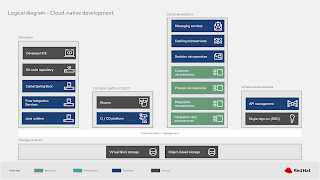 |
| Part 6 - Advanced deployment architecture |
This article completes the series with a look at the advanced cloud-native deployment architecture. A description providing you with guidance for aligning this architecture to your organizational architecture follows.
These details should help you understand both what the elements contain and how they might align and how their functionalities are grouped. Let's look at the use case where developers are leveraging a remote container platform for their cloud-native development environments and see how that's mapping to a productive working architecture for deploying their solutions.

